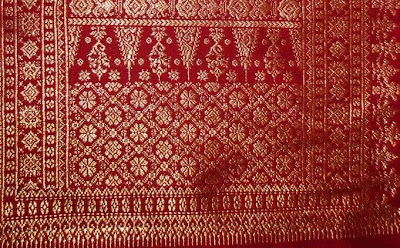 Since long before, South Sumatera has been known with its traditional crafts like weaving, plaiting, wood carving, ceramics and metal-craft. Hereditary, these art craft has not change much. It is caused by the fact that most of those products are utilized as equipments in the adapt ceremonies.
Since long before, South Sumatera has been known with its traditional crafts like weaving, plaiting, wood carving, ceramics and metal-craft. Hereditary, these art craft has not change much. It is caused by the fact that most of those products are utilized as equipments in the adapt ceremonies.It has been mentioned about the tradition to decorate the adapt-house with wood-carving. This wood carving art does not only produce home decoration, but also furniture. Characteristics of South Sumatra wood carving art, especially that of Palembang, is the density and excessiveness of the decoration with see through technique using plant-motives with symbolism. The decorative impression is more conspicuous due to the application of different colours on the decoration. The most popular colours are gold-coating and red (lac), a tradition which supposed to be originated from Chinese decorative art.
 Along the development of wood carving art, the songket-weaving art has also been developed, especially in Palembang where it later further expanded to the Meranjat OKI region. The songket-weaving art has been known already since the Sriwijaya period, when silk and gold yarns were used. The plant decorative motives seen at the woodcarving decoration appear again at the songket decorations. According to the applied decorative motives and their designs, several names of songket weaving are known as Songket Lepus, Songket Naga Berdaung, Songket Bunga jatuh, Songket Bunga Cina, Songket Bertabut, Songket janda berhias, etc. The songket weaving are available in the form of sarong, shawl and headcloth. In latest development songket weaving are produced for various outfits of divans, back and seat of chairs, table coats, etc.
Along the development of wood carving art, the songket-weaving art has also been developed, especially in Palembang where it later further expanded to the Meranjat OKI region. The songket-weaving art has been known already since the Sriwijaya period, when silk and gold yarns were used. The plant decorative motives seen at the woodcarving decoration appear again at the songket decorations. According to the applied decorative motives and their designs, several names of songket weaving are known as Songket Lepus, Songket Naga Berdaung, Songket Bunga jatuh, Songket Bunga Cina, Songket Bertabut, Songket janda berhias, etc. The songket weaving are available in the form of sarong, shawl and headcloth. In latest development songket weaving are produced for various outfits of divans, back and seat of chairs, table coats, etc.Ceramic art of South Sumatra has been know since former times having produced daily necessity equipments like pitchers, cooking-pots, boilers, water-barrels, braziers, water-pitchers, money-boxers, etc.
Kayu Agung city is a centre of ceramic art beside Poya Kabung village which produces especially decoration ceramics. In the latest development, in Mentok and Sungailiat (Bangka) a sort of porcelain ceramics has been produced as industrial article. This fact is supported by the availability of high grade ceramic material in that area.
 The plait-craft tradition started as side production efforts for own consumption. Bamboo and rattan are the main material to produce plaitware as baskets, mats, hats, dish-cover, bags, etc.
The plait-craft tradition started as side production efforts for own consumption. Bamboo and rattan are the main material to produce plaitware as baskets, mats, hats, dish-cover, bags, etc.The Payung and Kelapa sub-districts of Bangka are well-known of their platcraft producing Kopiah (cap) made of resam, a sort of fern. Acquainted with foreign craft products and stimulated by the needs to sell, then furniture of rattan are produce, as chairs, beds, lamp-shades, book-selves, buffets, etc.
For the outfit of adapt wedding, beside songket weaving articles, the crafts of metal-smiths are also needed, which manufacture ankle and armbraceletsm brest-decorations, shoulder-decorations, belts, rings, hair-decorations (crown) etc. Materials used therefore are gold, silver, or brass blending with hammering, carving, shaping and welding technique. The Penganggon and the Gede decorations are outfits for adapt wedding, which demonstrate traditional decorative-art beauty-value being produced in the region of Palembang. The precious metal smithy art tradition has gradually disappeared. Palembang, the city once know as a centre of activity of this art, there is today rare of craftmen producing outfits for traditional wedding. Meranjat OKI is also known as a centre of gold-craft, beside being a centre of songket weaving, as mentioned before.